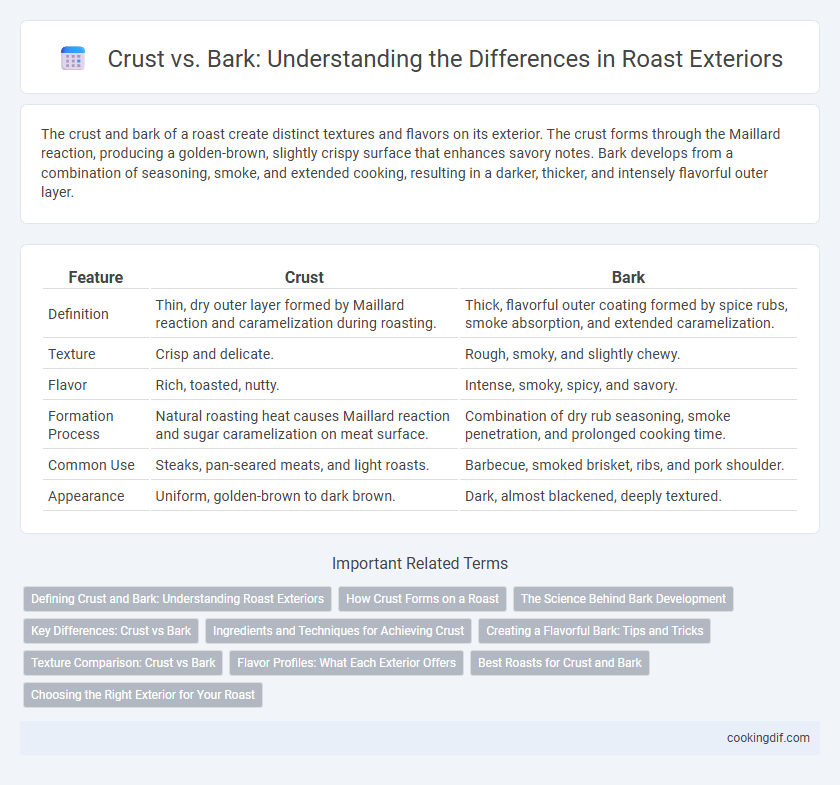The crust and bark of a roast create distinct textures and flavors on its exterior. The crust forms through the Maillard reaction, producing a golden-brown, slightly crispy surface that enhances savory notes. Bark develops from a combination of seasoning, smoke, and extended cooking, resulting in a darker, thicker, and intensely flavorful outer layer.
Table of Comparison
| Feature | Crust | Bark |
|---|---|---|
| Definition | Thin, dry outer layer formed by Maillard reaction and caramelization during roasting. | Thick, flavorful outer coating formed by spice rubs, smoke absorption, and extended caramelization. |
| Texture | Crisp and delicate. | Rough, smoky, and slightly chewy. |
| Flavor | Rich, toasted, nutty. | Intense, smoky, spicy, and savory. |
| Formation Process | Natural roasting heat causes Maillard reaction and sugar caramelization on meat surface. | Combination of dry rub seasoning, smoke penetration, and prolonged cooking time. |
| Common Use | Steaks, pan-seared meats, and light roasts. | Barbecue, smoked brisket, ribs, and pork shoulder. |
| Appearance | Uniform, golden-brown to dark brown. | Dark, almost blackened, deeply textured. |
Defining Crust and Bark: Understanding Roast Exteriors
Crust refers to the caramelized, crisp outer layer of a roast formed by the Maillard reaction and browning during cooking, characterized by a slightly thicker, uniform texture. Bark is a specific type of crust found mainly on smoked or barbecued meats, developing through the combination of spice rubs, smoke, and extended cooking times, resulting in a darker, flavorful, and more textured exterior. Understanding the difference between crust and bark is essential for achieving desired flavor profiles and textures in various roasting methods.
How Crust Forms on a Roast
Crust formation on a roast occurs through the Maillard reaction, where proteins and sugars undergo complex chemical changes under high heat, creating a flavorful, browned exterior. The crust develops as surface moisture evaporates and heat promotes caramelization and protein denaturation, resulting in a distinct textural contrast to the interior. Factors influencing crust quality include roasting temperature, duration, and initial seasoning, which contribute to the depth of flavor and color on the roast's surface.
The Science Behind Bark Development
Bark development on a roast results from the Maillard reaction and caramelization, creating a flavorful, aromatic crust that enhances texture and taste. The bark forms when heat interacts with seasoning and meat proteins, producing complex flavor compounds and a dark, crispy exterior. This chemical process distinguishes bark from a simple crust by its deeper flavor profile and thicker, more textured surface.
Key Differences: Crust vs Bark
Crust and bark are distinct exterior layers formed during roasting, with crust referring to the thin, caramelized outer surface created by the Maillard reaction and sugar caramelization. Bark, commonly associated with smoked or slow-roasted meats, is a thicker, darker, and more textured layer resulting from seasoning rubs, smoke absorption, and prolonged cooking. Understanding these key differences helps achieve desired flavor profiles and textures in various roasting techniques.
Ingredients and Techniques for Achieving Crust
Achieving the perfect roast crust requires a combination of high heat searing and dry seasoning techniques such as salt, pepper, and aromatic herbs to enhance the Maillard reaction. Ingredients like sugar or honey can caramelize the exterior, adding complexity and depth to the crust while minimizing moisture ensures a crisp texture. Contrast this with bark, typically associated with slow-smoked meats, where spice rubs and smoke penetration create a thick, flavorful outer layer distinct from the rapid Maillard-driven crust on roasted dishes.
Creating a Flavorful Bark: Tips and Tricks
Creating a flavorful bark on roast requires a balance of heat, seasoning, and moisture control, where the Maillard reaction develops rich, complex flavors and a crispy texture. Using a dry rub with salt, sugar, and spices enhances caramelization while ensuring the roast surface is well-patted dry promotes a robust crust formation. Cooking at the right temperature range, around 225-275degF for slow roasting or finishing with a high heat sear, intensifies the bark's texture and depth of flavor.
Texture Comparison: Crust vs Bark
The crust on a roast is typically thinner and forms from the Maillard reaction, resulting in a slightly crispy yet tender exterior. Bark, found mostly on smoked meats, is thicker and textured due to a combination of spice rubs, smoke absorption, and prolonged cooking, creating a robust, crunchy outer layer. Texture-wise, crust offers a delicate chew while bark provides a pronounced, flavorful crunch that enhances the eating experience.
Flavor Profiles: What Each Exterior Offers
Crust forms through the Maillard reaction, delivering a deep, savory flavor with caramelized notes that enhance the roast's overall taste. Bark, common in barbecue, combines a spice rub with smoke, creating a complex exterior rich in smoky, spicy, and slightly sweet flavors. Both crust and bark intensify the roast's flavor but offer distinct profiles: crust emphasizes umami and caramelization, while bark highlights smokiness and spice complexity.
Best Roasts for Crust and Bark
A perfect roast exterior balances crust and bark, where crust forms a thin, flavorful layer from Maillard reactions, and bark develops a thicker, textured coating infused with seasoning and smoke. Best roasts for crust include prime rib and beef tenderloin, which benefit from high heat to create a crisp, savory surface without overpowering the tender interior. For bark, smoked brisket and pork shoulder excel, absorbing spices and wood smoke to form a robust, deeply flavored crust essential to barbecue excellence.
Choosing the Right Exterior for Your Roast
Choosing the right exterior for your roast involves understanding the difference between crust and bark. Crust forms from caramelized sugars and proteins during high heat roasting, providing a crunchy, flavorful layer. Bark develops through a slow-smoking process combined with spices and smoke, resulting in a deeply seasoned and textured outer layer prized in barbecue culture.
Crust vs Bark for roast exterior Infographic

 cookingdif.com
cookingdif.com